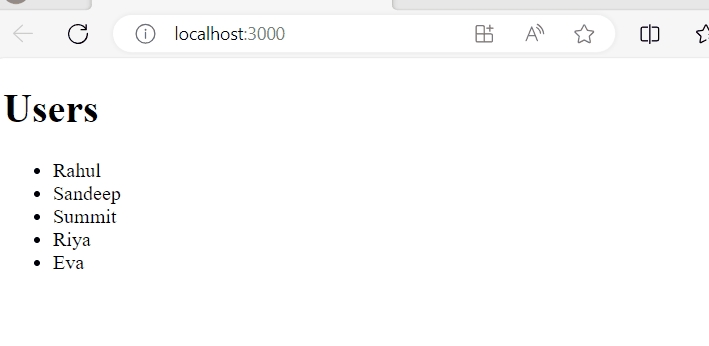Creating custom middlewares in React Redux
Last Updated :
19 Feb, 2024
In React-Redux applications, managing the flow of data is crucial for building efficient and scalable apps. Redux provides a powerful state management solution, and custom middleware adds an extra layer of flexibility to handle complex scenarios effectively.
Let’s understand custom middleware in simpler terms and see how we can create and use them.
What is Middleware?
When you dispatch an action in your application, it goes through a series of checkpoints before reaching the reducers. These checkpoints are the middleware. They intercept actions, perform specific tasks, and then pass them along to the next middleware or finally to the reducers. Middlewares in React Redux act as a bridge between actions being dispatched and reducers that update the state accordingly. They intercept actions before they reach reducers, allowing for additional functionality such as logging, asynchronous operations, or dispatching multiple actions based on a single action.
Creating Custom Middleware:
To create a custom middleware, you define a function that follows a particular pattern. This function receives the Redux store as its first parameter and returns another function. This returned function then takes next as its parameter, which represents the next middleware in the chain. Inside this function, you’ll handle your custom logic and eventually call next(action) to pass the action forward.
Step 1: Middleware Structure First, let’s define the structure of our middleware function. A middleware in Redux is a function that returns another function, which takes store as its argument. This function then returns another function that takes next as its argument, representing the next middleware in the chain.
const customMiddleware = store => next => action => {
// Middleware logic goes here
}
Step 2: Implement Middleware Logic Inside our middleware function, we can implement the desired logic. For example, let’s create a simple logger middleware that logs each dispatched action to the console along with the current state.
const loggerMiddleware = store => next => action => {
console.log('Dispatching action:', action);
console.log('Current state:', store.getState());
next(action);
}
Step 3: Apply Middleware to Redux Store to apply our custom middleware to the Redux store, we use the applyMiddleware function provided by Redux.
import { createStore, applyMiddleware } from 'redux';
import rootReducer from './reducers';
const store = createStore(rootReducer, applyMiddleware(loggerMiddleware));
Practical Use Cases:
Custom middlewares can be used for various purposes in React Redux applications. Some common use cases include:
- Authentication: Middleware can intercept actions related to user authentication, validate tokens, and handle authentication flows.
- Logging: As demonstrated above, middleware can log actions, state changes, or any other relevant information for debugging purposes.
- Asynchronous Operations: Middleware can handle asynchronous actions such as making API requests, dispatching multiple actions based on the result, or handling errors.
- Caching: Middleware can implement caching mechanisms to optimize performance by storing frequently accessed data locally.
Example: Below are the example to create custom middleware in React Redux.
- Install the necessary package in your application using the following command.
npm install react-redux redux
Javascript
import React, { useEffect } from 'react';
import { connect } from 'react-redux';
import { fetchUsersRequest }
from './actions/userAction';
const App = ({ users, loading, error, fetchUsers }) => {
useEffect(() => {
fetchUsers();
}, [fetchUsers]);
if (loading) {
return <div>Loading...</div>;
}
if (error) {
return <div>Error: {error}</div>;
}
if (!users || users.length === 0) {
return <div>No users found</div>;
}
return (
<div>
<h1>Users</h1>
<ul>
{users.map(user => {
return (
<li key={user.id}>{user.name}</li>
);
})}
</ul>
</div>
);
};
const mapStateToProps = state => {
return {
users: state.users || [],
loading: state.loading,
error: state.error
};
};
const mapDispatchToProps = dispatch => ({
fetchUsers: () => dispatch(fetchUsersRequest())
});
export default connect(mapStateToProps, mapDispatchToProps)(App);
|
Javascript
import React from 'react';
import { createRoot } from 'react-dom/client';
import { Provider } from 'react-redux';
import App from './App';
import store from './store';
const root = createRoot(document.getElementById('root'));
root.render(
<Provider store={store}>
<App />
</Provider>
);
|
Javascript
import { applyMiddleware, createStore } from 'redux';
import userReducer from './reducers/userReducer';
import apiMiddleware from './middleware/apiMiddleware';
const store = createStore(
userReducer,
applyMiddleware(apiMiddleware)
);
export default store;
|
Javascript
const apiMiddleware = store => next => action => {
if (action.type === 'FETCH_USERS_REQUEST') {
store.dispatch({ type: 'FETCH_USERS_LOADING' });
setTimeout(() => {
const users = [
{ id: 1, name: 'Rahul' },
{ id: 2, name: 'Sandeep' },
{ id: 3, name: 'Summit' },
{ id: 4, name: 'Riya' },
{ id: 5, name: 'Eva' }
];
store.dispatch({
type: 'FETCH_USERS_SUCCESS',
payload: users
});
}, 1000);
}
return next(action);
};
export default apiMiddleware;
|
Javascript
export const fetchUsersRequest = () => ({
type: 'FETCH_USERS_REQUEST'
});
export const fetchUsersSuccess = users => ({
type: 'FETCH_USERS_SUCCESS',
payload: users
});
export const fetchUsersFailure = error => ({
type: 'FETCH_USERS_FAILURE',
payload: error
});
|
Javascript
const initialState = {
users: [],
loading: false,
error: null
};
const userReducer = (state = initialState, action) => {
switch (action.type) {
case 'FETCH_USERS_REQUEST':
return { ...state, loading: true };
case 'FETCH_USERS_SUCCESS':
return {
...state, loading: false,
users: action.payload, error: null
};
case 'FETCH_USERS_FAILURE':
return {
...state, loading: false,
error: action.payload
};
default:
return state;
}
};
export default userReducer;
|
Start your application using the following command.
npm start
Output:

Output
Share your thoughts in the comments
Please Login to comment...